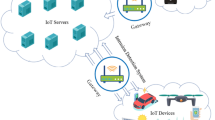Abstract
Network intrusion detection is important for protecting computer networks from malicious attacks. However, class imbalance in network traffic data can make it difficult to detect intrusions accurately. To address this challenge, we propose a novel deep learning model called the deep regularizer learning model (DRLM). DRLM uses sample similarity across categories to enhance its ability to learn from imbalanced data. To enhance the representation ability of the neural network, DRLM also employs a feature extraction encoder consisting, LayerNorm and Skip-connection units. DRLM uses a adaptive contrastive loss function to optimize the model during training. The model validation is done against IoT-23 dataset, a real-time traffic data from numerous smart home IoT devices. Experimental results showed that the DRLM outperformed existing methods, demonstrating its superior generalization ability and its ability to handle class imbalance without additional pre-training or fine-tuning.
Access this chapter
Tax calculation will be finalised at checkout
Purchases are for personal use only
Similar content being viewed by others
References
Abuadlla, Y., Kvascev, G., Gajin, S., Jovanovic, Z.: Flow-based anomaly intrusion detection system using two neural network stages. Comput. Sci. Inf. Syst. 11(2), 601–622 (2014). https://doi.org/10.2298/CSIS130415035A
Yousefi-Azar, M., Varadharajan, V., Hamey, L., Tupakula, U.: Autoencoder-based feature learning for cyber security applications. In: Proceedings of the International Joint Conference on Neural Networks (IJCNN), pp. 3854–3861, May 2017. https://doi.org/10.1109/IJCNN.2017.7966342
Zhang, B., Yu, Y., Li, J.: Network intrusion detection based on stacked sparse autoencoder and binary tree ensemble method. In: Proceedings of the IEEE International Conference on Communications Workshops (ICC Workshops), pp. 1–6, May 2018. https://doi.org/10.1109/ICCW.2018.8403759
Abolhasanzadeh, B.: Nonlinear dimensionality reduction for intrusion detection using auto-encoder bottleneck features. In: Proceedings of the 7th Conference on Information and Knowledge Technology (IKT), pp. 1–5, May 2015. https://doi.org/10.1109/IKT.2015.7288799
Mighan, S.N., Kahani, M.: Deep learning based latent feature extraction for intrusion detection. In: Proceedings of the Electrical Engineering (ICEE), Iranian Conference on, pp. 1511–1516, May 2018. https://doi.org/10.1109/ICEE.2018.8472418
Shone, N., Ngoc, T.N., Phai, V.D., Shi, Q.: A deep learning approach to network intrusion detection. IEEE Trans. Emerg. Top. Comput. Intell. 2(1), 41–50 (2018). https://doi.org/10.1109/TETCI.2017.2772792
Çekmez, U., Erdem, Z., Yavuz, A.G., Sahingoz, O.K., Buldu, A.: Network anomaly detection with deep learning. In: Proceedings of the 26th Signal Processing and Communications Applications Conference (SIU), pp. 1–4, May 2018. https://doi.org/10.1109/SIU.2018.8404817
Aygun, R.C., Yavuz, A.G.: A stochastic data discrimination based autoencoder approach for network anomaly detection. In: Proceedings of the 25th Signal Processing and Communications Applications Conference (SIU), pp. 1–4, May 2017. https://doi.org/10.1109/SIU.2017.7960410
Naseer, S., et al.: Enhanced network anomaly detection based on deep neural networks. IEEE Access 6, 48231–48246 (2018). https://doi.org/10.1109/ACCESS.2018.2863036
Chen, Z., Yeo, C.K., Lee, B.S., Lau, C.T.: Autoencoder-based network anomaly detection. In: Proceedings of the Wireless Telecommunication Symposium (WTS), pp. 1–5, April 2018. https://doi.org/10.1109/WTS.2018.8363930
KDD Cup 1999 Data. http://kdd.ics.uci.edu/databases/kddcup99/kddcup99.html. Accessed 30 Mar 2019
Farahnakian, F., Heikkonen, J.: A deep auto-encoder based approach for intrusion detection system. In: Proceedings of the 20th International Conference on Advanced Communication Technology (ICACT), pp. 178–183, Feburary 2018. https://doi.org/10.23919/ICACT.2018.8323688
Mebawondu, J.O., et al.: Network intrusion detection system using supervised learning paradigm. Sci. Afr. 9, e00497 (2020)
Alhajjar, E., Maxwell, P., Bastian, N.: Adversarial machine learning in network intrusion detection systems. Expert Syst. Appl. 186, 115782 (2021)
Sarker, I.H., et al.: Intrudtree: a machine learning based cyber security intrusion detection model. Symmetry 12(5), 754 (2020)
Wang, Y., et al.: Adaptive machine learning‐based alarm reduction via edge computing for distributed intrusion detection systems. Concurr. Comput. Pract. Exp. 31(19), e5101 (2019)
Moualla, S., Khorzom, K., Jafar, A.: Improving the performance of machine learning-based network intrusion detection systems on the UNSW-NB15 dataset. Comput. Intell. Neurosci. 2021, 1–13 (2021)
Zavrak, S., İskefiyeli, M.: Anomaly-based intrusion detection from network flow features using variational autoencoder. IEEE Access 8, 108346–108358 (2020)
Lopes, I.O., et al.: Effective network intrusion detection via representation learning: a denoising autoencoder approach. Comput. Commun. 19, 55–65 (2022)
Yang, J., et al.: Conditional variational auto-encoder and extreme value theory aided two-stage learning approach for intelligent fine-grained known/unknown intrusion detection. IEEE Trans. Inf. Forensics Secur. 16, 3538–3553 (2021)
Sun, J., et al.: Learning sparse representation with variational auto-encoder for anomaly detection. IEEE Access 6, 33353–33361 (2018)
Osada, G., Omote, K., Nishide, T.: Network intrusion detection based on semi-supervised variational auto-encoder. In: Foley, S., Gollmann, D., Snekkenes, E. (eds.) Computer Security – ESORICS 2017. ESORICS 2017. LNCS, vol. 10493, pp. 344–361. Springer, Cham (2017). https://doi.org/10.1007/978-3-319-66399-9_19
Dao, T.-N., Lee, H.: Stacked autoencoder-based probabilistic feature extraction for on-device network intrusion detection. IEEE Internet Things J. 9(16), 14438–14451 (2021)
Longari, S., et al: CANnolo: An anomaly detection system based on LSTM autoencoders for controller area network. IEEE Trans. Netw. Serv. Manag. 18(2), 1913–1924 (2020)
Kukkala, V.K., Thiruloga, S.V., Pasricha, S.: Indra: intrusion detection using recurrent autoencoders in automotive embedded systems. IEEE Trans. Comput.-Aided Des. Integr. Circuits Syst. 39(11), 3698–3710 (2020)
Author information
Authors and Affiliations
Corresponding author
Editor information
Editors and Affiliations
Rights and permissions
Copyright information
© 2024 The Author(s), under exclusive license to Springer Nature Switzerland AG
About this paper
Cite this paper
Bhavani, A.D., Mangla, N. (2024). A Novel Approach of Intrusion Detection System for IoT Against Modern Attacks Using Deep Learning. In: Silhavy, R., Silhavy, P. (eds) Software Engineering Methods in Systems and Network Systems. CoMeSySo 2023. Lecture Notes in Networks and Systems, vol 909. Springer, Cham. https://doi.org/10.1007/978-3-031-53549-9_18
Download citation
DOI: https://doi.org/10.1007/978-3-031-53549-9_18
Published:
Publisher Name: Springer, Cham
Print ISBN: 978-3-031-53548-2
Online ISBN: 978-3-031-53549-9
eBook Packages: Intelligent Technologies and RoboticsIntelligent Technologies and Robotics (R0)




